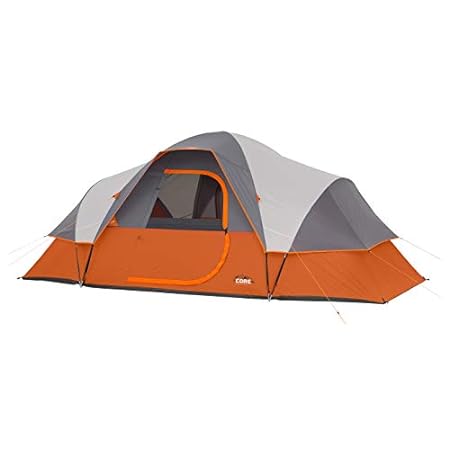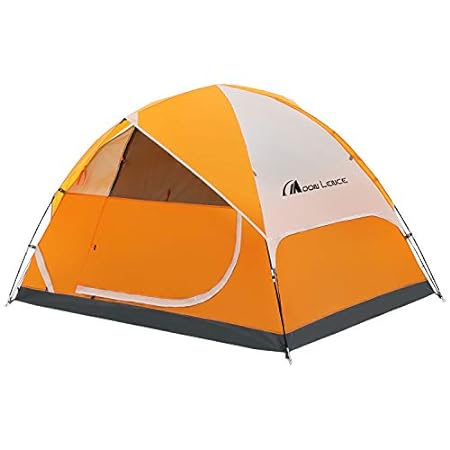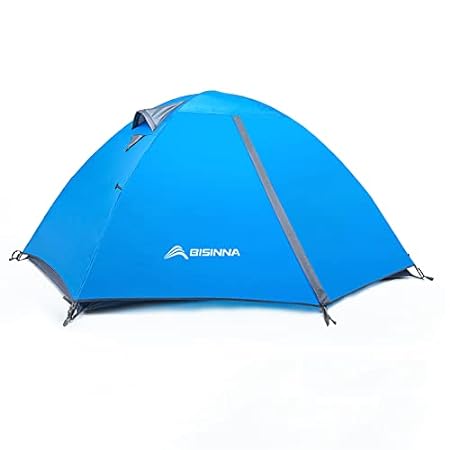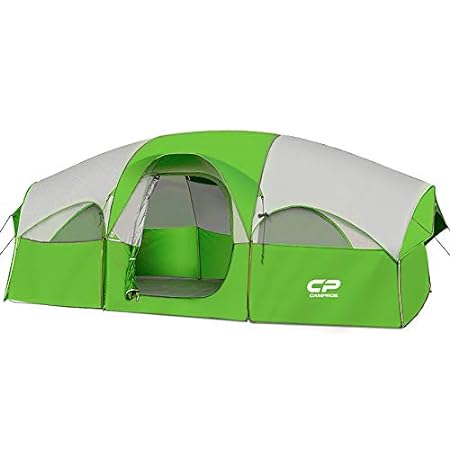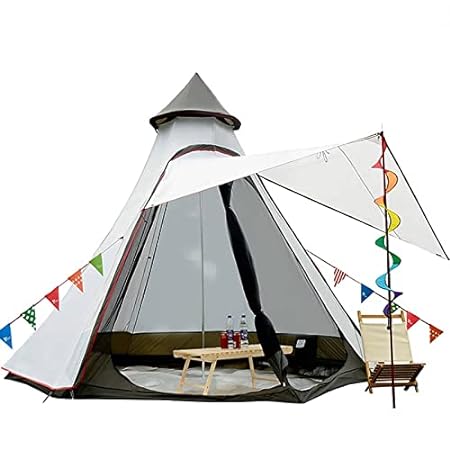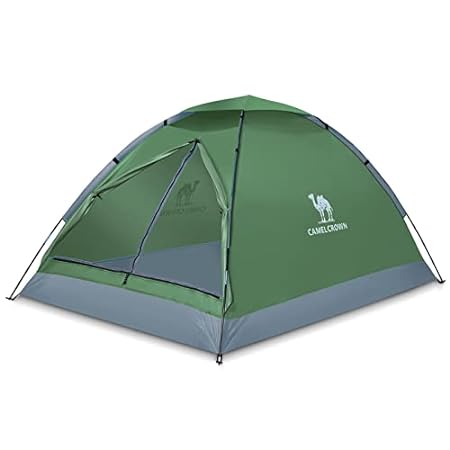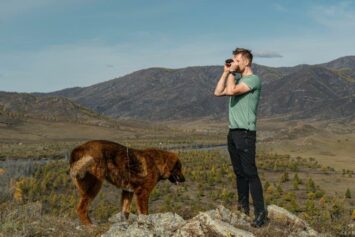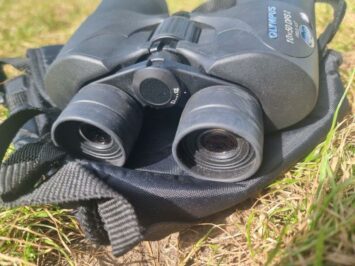The key to a good tent is its ability to withstand the elements. A great tent will keep you dry and cool in rainy weather, and warm and cozy in cold weather. This roundup of tents includes some of the best tents on the market for both rain and wind protection as well as other factors such as ease of setup, weight capacity, price, etc., which should make it easier for you to find your perfect match.

Quick Navigation
ToggleWhat is the Best Tent for Rain and Wind?
We have compiled for you the top 8 Best Tent for Rain and Wind in 2024. In this article we go through the products that we have used ourselves, checked what other users thought about them and we ranked them accordingly.
With years of experience with rain and wind-proof tents and having used several tents for rain and wind you can trust our review.
Moreover, you can scroll to the end of this review to see our mini buying guide as well as the answers to some of the frequently asked questions about tents for rain and wind.
1. Core 9 Person Extended Dome Tent
| Specs |
|---|
| Price: 💲💲💲 (fewer 💲 = cheaper) Size: 192 x 108 x 72 inches (487.7 x 274.3 x 182.9 cm) Size: 9 Persons Material: 68D Polyester Waterproof: 600 MM Instant: No Tent Type / Shape: Dome |
The Core 9-Person Extended Dome is a surprisingly lightweight tent at 18.25 pounds compared to the 9-person Cabin model that weighs 30.5 pounds. The Extended Dome also has a slightly larger footprint that makes it a little more spacious. However, you can only accommodate up to six campers if you want comfort and space to keep your gear inside the tent.
Although it is not an instant setup like the Cabin model, it takes most people less than 30 minutes to set up and peg it. But, many campers who’ve used this tent recommend replacing its stakes with better-quality ones. If you don’t know which pegs to get, I recommend reading this article to help you choose the best stakes for your tent. Another thing I don’t like is that Core tents typically feature their proprietary H2O Block technology that includes heat-sealed seams to keep the tent watertight.
However, it also gives the polyester tent material a low hydrostatic rating of 600mm, which is slightly better than the water resistance of an umbrella. It also features a single-layer design that only performs well in dry weather.
Overall, I like the extended sections that give you extra space for your gear and its attractive and sturdy design when pitched up. Although it has a couple of mesh sections, many users say that it has poor air circulation, which is a critical attribute considering you’ll mostly use it in the summer.
Pros
- Decent build quality and performance for occasional camping,
- Generous interior space and storage for group camping, Significantly lightweight construction for easy portability,
- Unique and attractive design with extended sections
Cons
- Poor ventilation that causes humidity,
- Features only one access point,
- Unreliable weather resistance
2. CAMPROS 6 Person Waterproof Windproof Family Tent
| Specs |
|---|
| Price: 💲💲💲💲 (fewer 💲 = cheaper) Weight: 20 pounds (9.07 kg) Size: 132 x 84 x 72 inches (335.3 x 213.4 x 182.9 cm) Size: 6 Persons Material: 185T Polyester Waterproof: 1000 MM Instant: No Tent Type / Shape: Cabin |
CAMPROS is an upcoming outdoor gear brand from Cambodia that produces camping tents and furniture for various markets. The 6-person camping tent model is part of a series of similar camping tents of different sizes and is suitable for small families. The tent features a simple design with 185T polyester construction and fiberglass poles that allows a quick 10-minute assembly and takedown.
It also offers a roomy interior which campers note can fit up to four people and their gear in comfort, but it would squeeze six campers. I like the headroom height that allows the average adult to stand straight and the storage pockets and gear loft for keeping small items inside the tent.
On the other hand, the tent features large mesh windows on its sides and roof for ventilation. However, it does not come with ground vents which would make it breathable at night, and some campers have noted that the tent gets stuffy as a result. It has a decent waterproof rating which means it can withstand moderate rain, but it performs best in dry weather.
Pros
- Has quick assembly and repacks easily in the carry bag,
- Good quality and robust construction for camping enthusiasts,
- Generous interior space offers comfortable living,
- Tall headroom space makes maneuverability easier
Cons
- It can be stuffy as it doesn’t have ground vents,
- The door zipper keeps snagging the flap
3. Moon Lence Camping Tent
| Specs |
|---|
| Price: 💲 (fewer 💲 = cheaper) Weight: 5.95 pounds (2.7 kg) Size: 83.8 x 59.8NaN inches (212.9 x 151.9NaN cm) Size: 2 Persons Material: 100% Polyester Waterproof: Yes |

As we delved deep into the world of camping tents, seeking the perfect blend of affordability and functionality, Moon Lence’s offering, priced under $200, quickly captured our attention. This 2-person, double-layered marvel, crafted from 100% polyester, transcended our expectations. Its sturdy 190T PU material, boasting both 1000mm water-resistance and UV-protection, resonated with our demand for quality. The tent’s assembly was no challenge either; in just about 15 minutes, we had our shelter ready, thanks to its 2 shock cord connecting poles. The lightweight iron pegs and guy lines ensured we slept soundly, undisturbed by the whims of the wind. Ventilation, a crucial aspect for us, was top-notch, with its dual windows, ground vents, and the generous mesh section ensuring a comfortable airflow. We particularly valued the detachable rainfly for those damp evenings and the internal mesh pockets coupled with a ceiling hook proved perfect for our nighttime essentials. After rigorous field tests, we are unanimous in our verdict: For backpackers in pursuit of a feature-rich yet pocket-friendly tent, Moon Lence emerges as a prime choice.
Pros
- Plenty of space and ventilation,
- Durable fabric and iron pegs,
- UV- and wind-resistant plus waterproof,
- Folds easy for storage
Cons
- Zipper sometimes gets stuck,
- No tent footprint included
4. BISINNA Lightweight Backpacking Tent
| Specs |
|---|
| Price: 💲💲 (fewer 💲 = cheaper) Size: 102.2 x 82.7 x 47.2 inches (259.6 x 210.1 x 119.9 cm) Size: 2 Persons Material: 190T Polyester Waterproof: 2000 MM Instant: No Tent Type / Shape: Dome |
Typically, most tents accommodate fewer people than they indicate they can because they don’t consider personal gear and elbow space. However, this Bisinna tent may be an exception as it features a significantly larger interior space than most tents of its size, and two campers may fit comfortably with their gear. However, it also makes an excellent solo camping tent for tall people, and I like that it features a vestibule so you can leave some of your gear outside if it’s not raining.
It has a decent quality build for its price range, and it has a full-coverage rainfly that makes it suited for 3-season camping. Additionally, it features UV protection which reduces heat inside the tent when you pitch it in direct sun. On the other hand, its PU-2000mm hydrostatic rating allows the tent to withstand moderate inclement weather for several hours without stress.
Pros
- High-quality and lightweight construction for backpacking,
- The double-layered design provides comfortable livability,
- It offers more space for two campers than the competition,
- Delivers excellent performance in moderate rain and wind
Cons
- Zippers are light-duty and may break quickly,
- It does not come with a groundsheet
5. Forceatt Tent for Camping
| Specs |
|---|
| Price: 💲💲 (fewer 💲 = cheaper) Size: 88.6 x 53.1 x 43.3 inches (225 x 134.9 x 110 cm) Size: 2 Persons Material: 75D 190T Polyester Waterproof: 5000 MM Instant: No Tent Type / Shape: Dome |
If you’re a solo camper looking for a solid tent that won’t break the bank, the Forceatt 2-person tent should be on your shortlist. The construction is robust, and it stands up well to both wind and rain. Ventilation is another strong point, thanks to the two D-shaped doors and ample mesh fabric. However, if you plan to share this space, consider going for the 3-person model; the 2-person version is sometimes a bit too cozy for two people to share space reasonably.
Pros
- Extremely sturdy,
- Easy assembly,
- Great ventilation,
- High-quality rainfly,
- Waterproof zippers
Cons
- Strange odor coming out of the package,
- Flimsy tent stakes
6. CAMPROS 8 Person Waterproof Windproof Family Tent
| Specs |
|---|
| Price: 💲💲💲💲 (fewer 💲 = cheaper) Size: 168 x 108 x 72 inches (426.7 x 274.3 x 182.9 cm) Size: 8 Persons Material: 185T Polyester Waterproof: 1000 MM Instant: No |
Camping is usually more fun when you have your family and friends with you, and camping tents such as this CAMPROS 8-person model can give you the space you need for group camping trips. Generally, tent dimensions determine how many people you can fit inside, but experienced campers advise getting a tent that accommodates more people than those on the trip.
This tent is no different, and several campers have noted that it fits four and six people comfortably with adequate space to move around and not eight people as indicated.
The tent features large mesh panels for ventilation, and while it does not come with ground vents, it allows air circulation notably well, and the mesh panels on the tent roof are great for watching stars in the summer. Plus, you can divide the space inside into two rooms with a curtain for privacy, and it also works as a projector screen for entertainment.
Furthermore, the tent’s design allows easy setup that takes an average of 10 minutes, and its structure remains stable and waterproof in light rain. But interestingly, this tent is 3lbs lighter than the 6-person model, although it comes with the same construction features.
Pros
- Robust tent with high-quality poles and zippers,
- The room divider also works like a movie projector screen,
- Large mesh windows and roof panels keep the tent cool,
- Agile construction that’s convenient to carry
Cons
- The tent performs better in dry weather,
- Floor material may tear quickly
7. Vidalido Dome Camping Tent
| Specs |
|---|
| Price: 💲💲💲 (fewer 💲 = cheaper) Size: 144 x 120 x 96 inches (365.8 x 304.8 x 243.8 cm) Size: 5 Persons Material: 150D Oxford Fabric Waterproof: 3000 MM Instant: No Tent Type / Shape: Tipi |
The Vidalido camping tent is a double-layer, tipi-style tent ideal for family camping or providing canopy shelter at festivals or in your backyard. The tent comes in two sections that include an inner and outer tent that you can use separately. The interior space is adequate to fit four people comfortably with room for maneuvering and is easy to assemble. However, it comes with poorly translated instructions for the setup that may be difficult to follow.
The inner section is a bathtub floor tarp with 120T anti-tear polyester mesh siding ideal for camping in warm environments. It’s also an excellent choice for stargazing in your backyard in the summer while protecting you from mosquitoes and other insects. The 150D Oxford fabric full-coverage rainfly is fantastic for camping in the rain, and it comes with a roof vent to keep condensation at a minimum.
Pros
- Versatile two-part tent for multifunctional use
- Decent build quality with taped seams and sturdy zippers
- Excellent ventilation with full mesh inner tent
- Generous interior space with 8-foot headroom
Cons
- Thin construction fabric can rip quickly
- The main post in the middle can be an inconvenience
8. CAMEL CROWN Camping Dome Tent
| Specs |
|---|
| Price: 💲 (fewer 💲 = cheaper) Weight: 4.89 pounds (2.22 kg) Size: 86.6 x 59 x 43.3 inches (220 x 150 x 110 cm) Size: 2 Persons Material: 150D Oxford Polyester Waterproof: 2000 MM Instant: No Tent Type / Shape: Dome |
This Camel Crown 2-person tent is remarkably lightweight for backpacking and comes in a spacious carry bag that allows repacking the tent hassle-free. The tent features the standard size and design that one would expect for a tent in this price range.
It also comes with a thick 150D Oxford Polyester material that makes it more resilient in inclement weather than most tents. Additionally, I like that its rainfly goes all the way to the bottom, which helps to keep the tent warm when it gets cold.
The inner tent features a mesh top and door that help to keep it ventilated, while the rainfly provides roof vents to reduce condensation when sleeping. However, the tent is small to fit two adults with their gear comfortably, plus the vestibule is too narrow to stash your camping pack. Overall, it is good quality and affordable tent for camping in fair weather and is easy to assemble and take down.
Pros
- Lightweight and convenient for backpacking,
- Features a thick and robust polyester material,
- Great for cold weather camping,
- Allows hassle-free assembly and takedown
Cons
- Zippers are not waterproof and may leak,
- It may be small for two campers
Verdict
To summarize, we have gone through dozens of tents for rain and wind and decided that 8 are worth your consideration. Out of these, the absolute Best Tent for Rain and Wind is Core 9 Person Extended Dome Tent which we highly recommend as our overall best.
If money is not an issue, you can consider CAMPROS 6 Person Waterproof Windproof Family Tent as this is our Premium Pick.
Otherwise, there’s no shame in spending prudently, Moon Lence Camping Tent is the Budget Option.
Our other reviews you may find useful in your research:
- Best Backpacking Tent Under 200
- Best 2 Person Backpacking Tent Under 100
- Best Family Tents for Bad Weather
What You Should Know Before Buying tents for rain and wind
Water, Wind and Snow Resistance
Manufacturers of backpacking tents under 100 use different features to make their tents sturdier and comfortable in any condition. They use sturdy designs like round dome designs to stop snow from gathering on the tent and a rainfly that extends to the ground for protection against rain. Poles and stakes are also used to drive the tent into the ground and stabilize it, while heavy-duty water-resistant fabrics are used for protection against rain.
Durability
Your tent’s material and floor type greatly contributes to its overall durability. Quality fabrics stand the test of time, whereas some materials deteriorate more quickly. The floor material plays a crucial role in keeping the interior dry, even in wet conditions. For those journeying into rugged landscapes, adding an extra ground liner is a smart move to shield your tent floor from potentially damaging elements.
Weight
When considering the weight of a tent, it’s crucial to be aware of the term ‘packaged weight’. This encompasses the tent’s total weight when purchased and includes every item it comes packaged with. From the main tent body and rainfly to the guylines, poles, and stuff sacks, everything counts. Notably, this also includes the all-important tent stakes, which are essential for securing your tent.
Size
You need to keep your tent’s overall size in mind when choosing one. While traversing various terrains, we always prioritize comfort and space in our shelters. However, durability, weight, and cost are equally vital. As a guideline, we’ve found that a 2-person tent measuring approximately 230 x 160 cm with a height of 100 cm provides an optimal balance. But, of course, adventurers can opt for something more tailored to their specific needs.
Ventilation & Heat Resistance
One thing you need to consider when it comes to ventilation is the extent of mesh on the tent body. For those sweltering days, having ample mesh windows becomes crucial for maintaining a refreshing air flow. While pitching the tent away from direct sunlight and pulling back the rainfly can assist in cooling, the waterproof coating on most rainflies can compromise air circulation and lead to internal condensation. A handy remedy we’ve discovered? Opting for tents with roof vents on the inner layer. This feature, coupled with a rainfly, introduces a gap between the two materials, balancing out ventilation and rain protection perfectly.
Pole and Stakes
Backpacking tents come with strong low-weight poles that are used for pitching tents. Poles are made from aluminum, optic fiber, and other durable materials.
Stakes (or pegs) are used for driving the tent into the ground and holding it there. They are shaped like a spike and made from metal, plastic, or wooden materials. They can either be connected to ropes that are attached to the tent or directly attached to the tent material.
Zips
Tent zippers are an essential feature and they can be the difference between an enjoyable camping experience and a horrid one. While manufacturers commonly use a coil zip or tooth zip, the deciding factor is the strength and flexibility of zips and if they are water-resistant.
Rainfly Color
Choosing bright and light rainfly colors improve illumination inside the tent and make the interior brighter. It can also make the tent a pleasant place to be during a storm that keeps you inside for long.
Setup
No one wants a tent that will take the whole day to set up. When buying a tent, you want one that you can set up quickly and efficiently. This is why most outdoor lovers prefer freestanding tents as they are easier to use and set up. While freestanding tents have a fixed pole system that you can set up anywhere, including rocky areas, you need trekking poles, stakes, and guylines to set up non-freestanding tents. This makes non-freestanding tents harder to pitch because they require mastery, time, and space.
Questions and Answers About tents for rain and wind
Can a tent withstand 50 mph winds?
A tent is not a very good idea for protecting your family in winds of 50 mph. That’s more than enough to shred it and potentially hurt those who are inside.
What wind speed is bad for tents?
This is a difficult question to answer because it depends on a variety of factors. The type and size of a tent can impact its ability to resist being blown away by the wind. The ground you put the tent on also has an impact. It would be worth checking with a local guide on what sort of tent is required for your location and what wind speed could be too fast for it.
How do you stop a tent flapping in the wind?
The flapping of a tent in the wind can be both an annoyance and a safety issue but there are things you can do to alleviate the problem.
The first step is to decide if it’s worth keeping your tent in a windy location or not. If possible, it’s best to find more sheltered ground for pitching the tent, even if it means moving further away from your intended destination. If you do need to stay, you can make several modifications. The most effective is adding guy lines every few feet along each side of the tent (at least four on each side). And make sure your tent stakes are big enough to hold the tent down!
Are tents OK in the rain?
The answer to this question is yes, at least in most cases. A tent in the rain is ok, as long as its waterproof rating is sufficient for the severity of the rain. Still, that doesn’t mean you will like camping in the rain, so if possible, try to avoid camping when the weather forecast indicates heavy rains.
What is the best waterproof tent material?
Waterproof tent material can be made from a number of different materials including canvas, nylon, and polyester. Some people believe that nylon or polyester are the best options because they do not absorb any moisture as canvas does. These materials are also lighter than canvas, so they can be used to make lightweight tents.
However, there are some issues with waterproof tent material (nylon or polyester) that need to be noted.
The first problem is that the plastic coating used on the fabric can rub off when you’re camping. If this plastic rubbing happens regularly, then it will degrade and lose its protection against water. The second problem is that this material cannot be completely waterproofed or it will affect the fabric’s elasticity and strength.
A number of tents are made from canvas rather than nylon. This material is not as waterproof, but it does breathe better. Canvas is also much more durable and can be easily repaired when worn.
